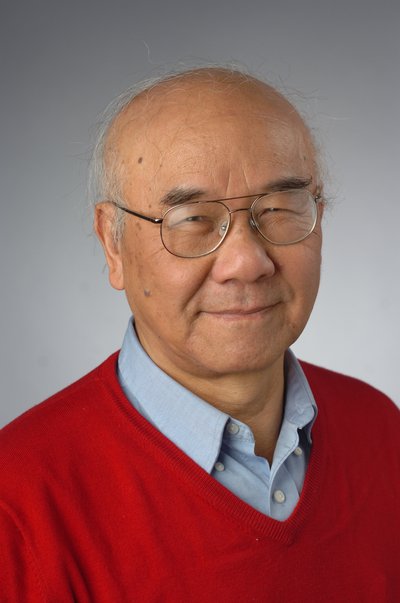Samuel H. P. Chan

Samuel H. P. Chan
Emeritus Professor
CONTACT
Biology
342 Life Sciences Complex
Email: sachan@syr.edu
PROGRAM AFFILIATIONS
Biophysical Science
Bioenergetics of subcellular organelles.
Program Overview
Bioenergetics, particularly the mechanism by which subcellular organelles such as mitochondria convert nutrients into ATP for cellular activities. Membrane-bound enzyme complexes, including cytochrome oxidase, adenine nucleotide translocase, and ATPase from normal and pathological tissues are studied.
Undergraduate Research Opportunities
The research in my lab consists of three separate, but related, topics as follows:
- Isolation and characterization of cytochrome oxidase protein subunits from mammalian mitochondria and two micro-organisms (Thermophilic bacteria P53 and Thiobacillus ferrioxidans). Our goal is to compare the common protein subunits and their individual functions. The procedures to identify these subunits are by Elisa and Western blot analyses using polyclonal and monoclonal antibodies previously prepared against the mammalian species. So far, we have found that the three largest subunits are common in all cytochrome oxidase samples, while little information is known about the smaller subunits. Our eventual aim is to understand the detailed enzyme mechanism of this important terminal member of electron transport chain and its contribution to energy transduction.
- In related studies to the above, another project is to elucidate the function of the mitochondrial ATPase inhibitor protein in relation to malignant hepatoma, as well as animal tissues of various age and artificially induced toxicity. Again, we are using Elisa and Western blot techniques for this purpose. Recently, the gene of this protein has been cloned in our laboratory by my former graduate student. We are measuring the in vivo level of this protein under various experimental conditions.
- Finally, recently we have identified a cholesterol-binding protein in the inter-membrane space between the two mitochondrial membranes both from normal and tumor tissues, although with elevated amounts in the latter. We believe that this protein may play a vital role in cholesterol accumulation in the tumor mitochondria and, hence, alters energy metabolism in the tumor tissue. There are a number important biochemical characterization studies on this protein to be done.
An undergraduate student interested in such studies is particularly welcome to join our laboratory.
- Ph.D., University of Rochester (1970)
- Postdoctoral fellow, Cornell University (1970-1972)
- BIO 475/675 Biochemistry Laboratory
- BIO 576 General Biochemistry II
- BIO 782 Biomembrane and Subcellular Organelles
BIO 460: Research in Biology
Taught Spring semesters
1-3 credits
Laboratory or field research under direct supervision of biology department faculty. Projects incorporate use of the scientific method, experimentation, data analysis, presentation and interpretation, and the responsibilities of scientific integrity.
BIO 475/675: Biochemistry Lab
Taught Fall semesters
3 credits
Experiments on amino acids, proteins, enzymes, fatty acids and nucleic acids, illustrating modern biochemical techniques applied to the chemistry of living cells. Titrations; electrophoresis; gel filtration; kinetics; spectrophotometric assays; cellular fractionation and analysis. Additional work required of graduate students.
BIO 576: General Biochemistry II
Taught Spring semesters
3 credits
Continuations of Biochemistry I. Mechanisms, integration, and regulation of intermediary, autotrophic, nitrogen, and energy metabolism. Structure, function, and metabolism of carbohydrates, lipids and proteins. Biogenesis and function of subcellular organelles.
BIO 782: Biomembrane and Subcellular Organelles
Taught Fall semesters
0-2 credits
Selected topics dealing with the structure and function of organelles and intracellular membrances. Students review, critically evaluate, and summarize recent literature on given topics. Summaries are presented and discussed in class.
CAS 101: Freshman Forum
Taught Fall semesters
1 credit
An introduction to the University in small discussion sections. Required of all first semester Arts and Sciences students. Diverse topics. Relevant reading and writing with discussions led by College of Arts and Sciences faculty members.
- Campbell, A.M. and Chan, S.H.P. (2008) Mitochondrial membrane cholesterol, the voltage dependent anion channel, and the Warburg effect, J. Bioenerg. Biomembrane. 40, 193-197.
- Campbell, A.M. and Chan, S.H.P. (2007) The voltage dependent anion channel affects mitochondrial cholesterol distribution and function. Arch. Biochem. & Biophys., 466, 203-210.
- Banerjee, A., Linscheer, W.G., Chiji, H., Murthy, U., Nandi, J. and Chan, S.H.P. (1998) Induction of an ATPase inhibitor protein by Propylthiouracil and protection against paracetamol hepatotoxicity in the rat. British J. of Pharma. 124, 1041-1047.
- Samuel, D.S., J. M. Belote, and S.H.P. Chan (1995) Isolation of the rat F1-ATPase inhibitor gene and its pseudogenes. Biochim. Biophys. Acta 1230, 81-85.
- Valkova-Valchanova, M.B. and S.H.P. Chan (1994). Purification and characterization of two new C-type cytochromes involved in Fe2+ oxidation from Thiobacillus fervooxidans. FEMS. Microbiol. Letters 121:61-70.
